The Role of TPN in Preventing Malnutrition in Long-Term Hospitalization
Understanding the Critical Role of TPN
Total parenteral nutrition (TPN) plays a vital role in managing and preventing malnutrition among patients undergoing long-term hospitalization, especially when gastrointestinal (GI) function is compromised. By delivering essential nutrients directly into the bloodstream, TPN ensures that patients receive tailored nutritional support, supporting recovery, maintaining body weight, and preventing the adverse effects of malnutrition. This article explores the comprehensive application of TPN, its components, indications, and significance in modern healthcare settings.
What is TPN and How Does It Support Nutritional Needs in Long-Term Hospitalization?
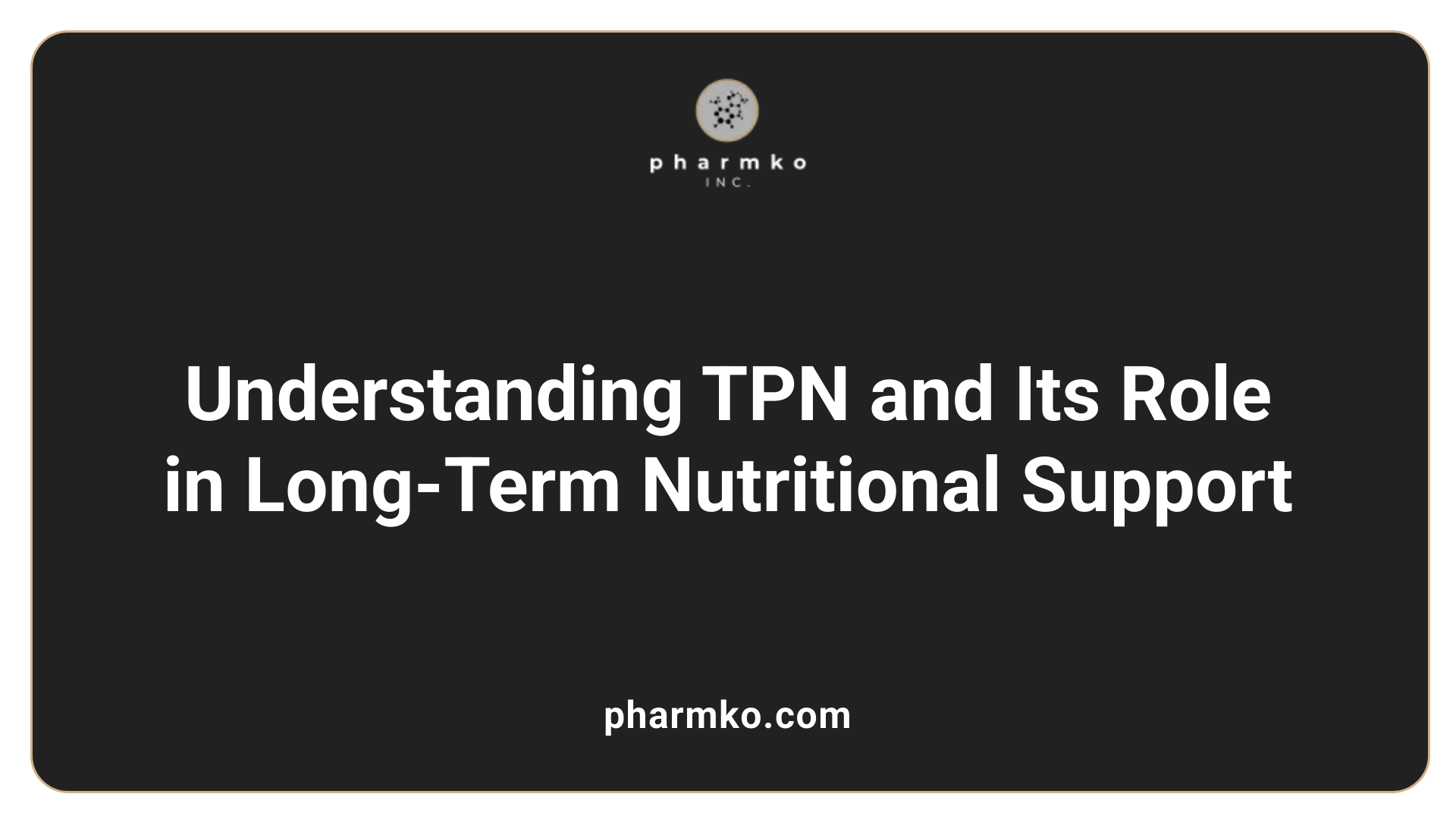
What is total parenteral nutrition (TPN) and how does it support nutritional needs during long-term hospitalization?
Total parenteral nutrition (TPN) is a specialized method of providing all necessary nutrients directly into a patient’s bloodstream through a vein. This approach bypasses the gastrointestinal (GI) tract entirely, making it ideal for individuals whose digestive systems cannot process or absorb nutrients properly.
TPN consists of a customized blend of water, carbohydrates (mainly dextrose), proteins (amino acids), fats (lipid emulsions), vitamins, minerals, and trace elements. This mixture is tailored to meet each patient’s specific metabolic and clinical needs, ensuring they receive a balanced nutritional intake.
This form of nutrition support plays a vital role during long-term hospital stays or even at home in cases of chronic or severe illnesses. Patients with gastrointestinal diseases, bowel obstructions, or those recovering from major surgeries often rely on TPN when their gut cannot function properly.
By ensuring adequate caloric intake and providing essential nutrients, TPN helps prevent malnutrition, maintain body weight, and support tissue healing and immune function. It is especially beneficial in maintaining nutritional status in patients who are unable to eat normally for extended periods.
Implementing TPN requires meticulous planning, proper sterile techniques, and ongoing monitoring. Regular laboratory tests assess electrolyte levels, glucose control, liver function, and signs of infection to prevent complications such as bloodstream infections, metabolic imbalances, or liver issues.
In summary, TPN serves as a life-sustaining nutritional modality that enables patients with compromised digestive systems to meet their nutritional requirements during prolonged hospitalizations, supporting recovery and improving quality of life.
Can TPN Be Used as Long-Term Nutritional Support?
Duration of TPN use
Total parenteral nutrition (TPN) can serve as a long-lasting solution for patients who cannot meet their nutritional needs through oral or enteral routes. It is particularly valuable for those with chronic gastrointestinal failure, such as in cases of short bowel syndrome, severe motility disorders, or irreversible bowel obstructions.
Most patients on long-term TPN receive continuous support for weeks, months, or even years. The duration depends on the underlying condition, response to therapy, and overall health. In many cases, TPN is used indefinitely, especially if other treatment options like surgery or transplantation are not feasible.
Survival and efficacy
Long-term TPN has demonstrated considerable effectiveness in enhancing survival and improving quality of life for patients with no options for enteral nutrition. Survival rates for long-term TPN are approximately 65-80% at three years, reflecting its role as a crucial intervention in managing chronic intestinal failure.
It maintains nutritional status, supports growth in pediatric populations, and prevents severe malnutrition. However, it requires specialized management to optimize outcomes and prevent complications.
Potential complications
Despite its benefits, long-term TPN is associated with significant risks. These include:
- Infections: Catheter-related bloodstream infections (CRBSI) are common and can be life-threatening.
- Liver disease: Cholestasis and hepatic steatosis may develop with prolonged TPN use.
- Mineral toxicity: Manganese accumulation has been reported, leading to neurological issues.
- Thrombosis: Venous access complications can include clot formation.
- Metabolic issues: Such as hyperglycemia, electrolyte imbalances, and nutrient overload.
Monitoring and early intervention are critical to managing these risks.
Monitoring and management
Effective long-term TPN use relies on meticulous monitoring and multidisciplinary care. Regular laboratory assessments include serum electrolytes, liver and kidney function tests, and blood counts. Indirect calorimetry helps tailor caloric intake to match metabolic demands.
Adjustments of the TPN formula are made based on ongoing evaluations. Proper aseptic technique during catheter insertion and maintenance minimizes infection risks. In some cases, the catheter may need to be replaced to prevent complications.
In addition to medical monitoring, patient education on catheter care, signs of complications, and when to seek medical help is essential. In some situations, intestinal transplantation might be considered if the patient does not tolerate or respond to conservative management.
While long-term TPN can keep patients alive and functional, it requires a well-coordinated effort between healthcare providers, patients, and caregivers to optimize safety and outcomes.
More Info: Search for "long-term use of TPN in chronic disease" to explore detailed studies and guidelines on managing extended TPN therapy.
Indications and Clinical Guidelines for TPN in Hospitalized Patients
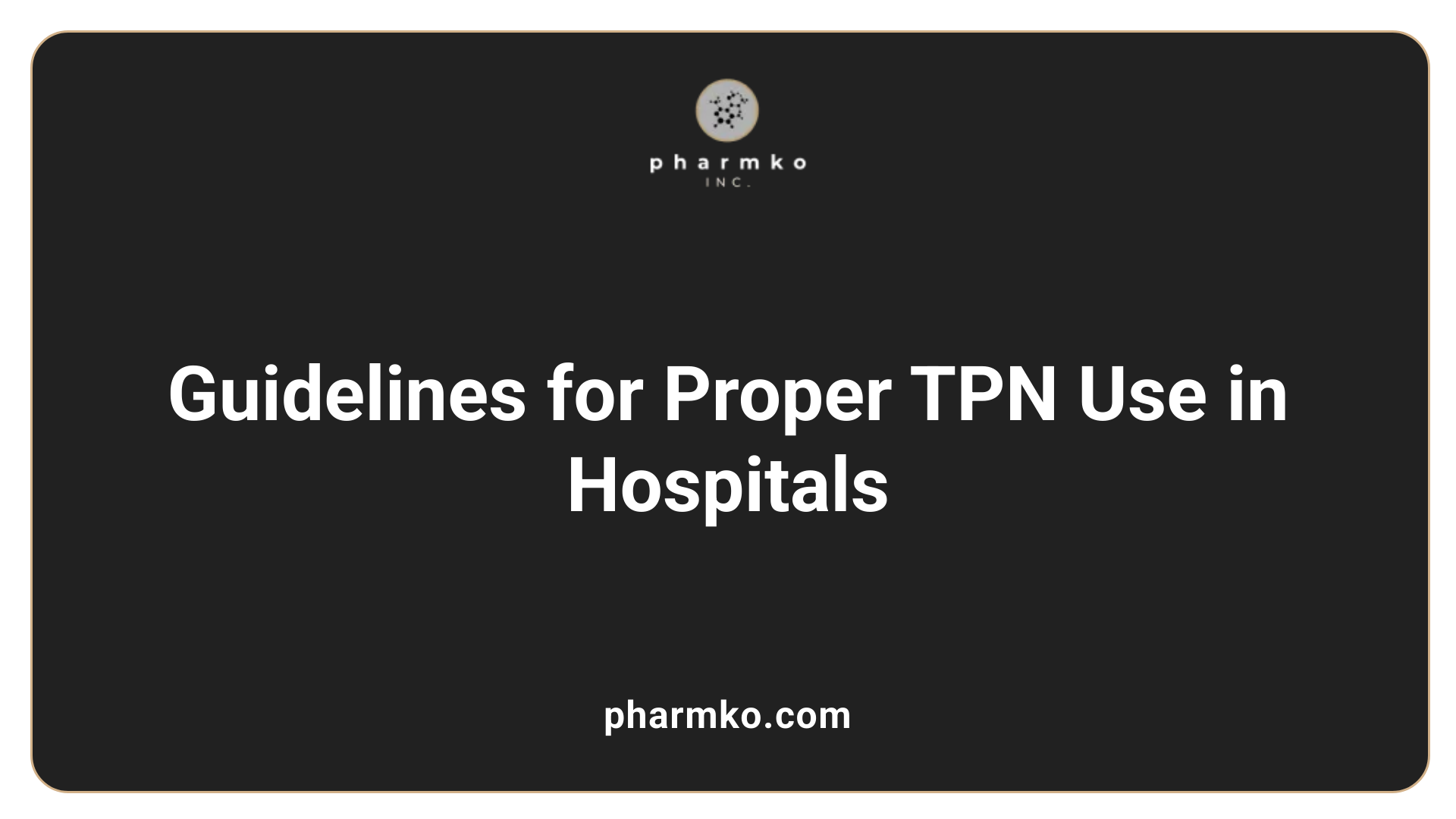
What are the indications and clinical guidelines for using TPN in hospitalized patients?
Total parenteral nutrition (TPN) is primarily used when a patient's gastrointestinal (GI) tract cannot be used effectively for nutrient absorption. It is particularly indicated in cases of extensive bowel resection, short bowel syndrome, severe diarrhea or vomiting, bowel obstruction, intestinal fistulas with high output, or post-operative bowel leaks.
TPN also plays a vital role in managing severe malnutrition, especially when enteral feeding is impossible or insufficient, such as during critical illnesses, abdominal trauma, or gastrointestinal diseases like Crohn's disease with intestinal failure.
Clinical guidelines underscore the importance of careful assessment before initiating TPN. This involves evaluating the patient's clinical status, nutritional needs, and gastrointestinal function. Initiation should follow confirmed indications, with a focus on providing tailored nutrition that supports wound healing, immune function, and growth in vulnerable groups like neonates and post-surgical patients.
Monitoring during TPN therapy is crucial. Regular laboratory tests are essential to detect electrolyte abnormalities, glucose levels, liver and kidney function, and signs of refeeding syndrome. Adjustments to TPN composition should be made based on ongoing assessment and lab results.
The choice between central and peripheral IV access depends on the osmolarity of the formula and the expected duration. Central venous access, such as PICC lines or implantable ports, is preferred for high-osmolarity solutions, whereas peripheral access may be used for short-term, lower-osmolarity feeds.
Overall, TPN should be strictly indicated, systematically monitored, and administered following evidence-based protocols aligned with guidelines from organizations such as ASPEN and ESPEN. Judicious use helps minimize complications like infections, metabolic disturbances, and catheter-related issues, ensuring safe and effective nutritional support for hospitalized patients.
Components of TPN Solutions
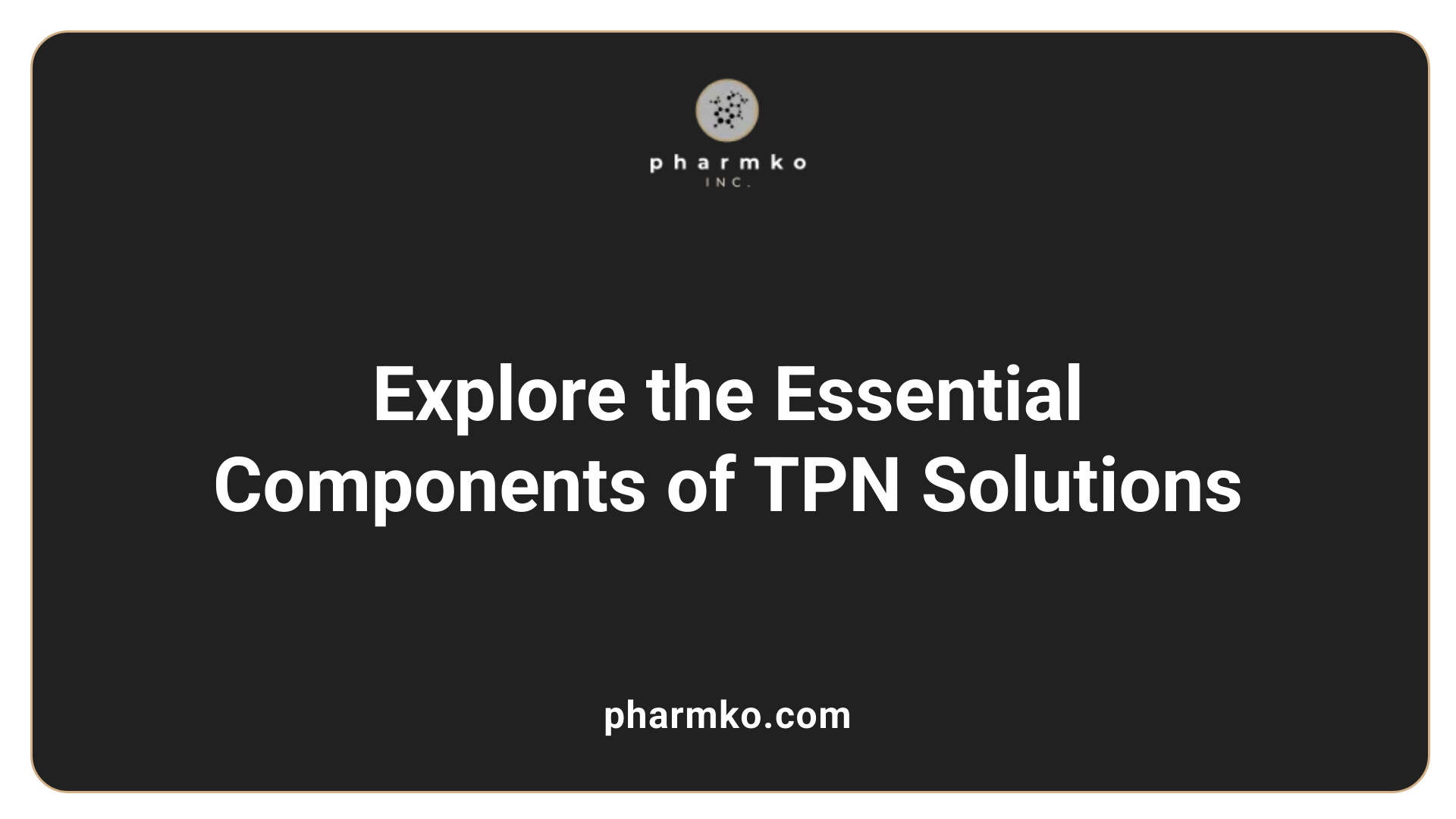 Total parenteral nutrition (TPN) solutions are carefully formulated mixtures designed to meet the diverse nutritional needs of patients unable to receive enteral feedings. These solutions primarily include water as a base, along with macronutrients, micronutrients, electrolytes, and various additives.
Total parenteral nutrition (TPN) solutions are carefully formulated mixtures designed to meet the diverse nutritional needs of patients unable to receive enteral feedings. These solutions primarily include water as a base, along with macronutrients, micronutrients, electrolytes, and various additives.
The main macronutrients in TPN are carbohydrates, proteins, and lipids. Carbohydrates are typically provided as dextrose monohydrate, which supplies the primary source of calories. Proteins are delivered through amino acids, offering essential and non-essential building blocks for tissue repair and maintenance. Lipids are administered as lipid emulsions to provide essential fatty acids and additional calories, helping prevent fatty acid deficiencies.
Micronutrients encompass a range of vitamins and minerals vital for metabolic processes. Vitamins such as vitamin C, B-complex, K, and E are included in water-soluble or fat-soluble forms, supporting immune function, energy production, and blood clotting. Minerals like calcium, potassium, phosphorus, magnesium, zinc, copper, selenium, and chromium are incorporated at specific concentrations tailored to the patient's requirements.
Electrolytes, including sodium, potassium, magnesium, calcium, and phosphorus, are also added in carefully determined amounts to maintain electrolyte balance and prevent deficiencies or excesses. Additional components may include medications such as insulin or heparin, which are added according to clinical protocols.
Each TPN formulation is customized based on a thorough clinical assessment, laboratory results, and individual nutritional needs. Proper preparation, infusion, and monitoring are essential to ensure safety and efficacy of the therapy.
Mechanisms and Benefits of TPN in Nutritional Support
What mechanisms and benefits does TPN provide in nutritional support?
Total parenteral nutrition (TPN) delivers essential nutrients directly into a patient’s bloodstream through a central venous catheter. Unlike oral or enteral feeding, TPN bypasses the gastrointestinal (GI) tract, making it ideal for individuals with impaired GI function or those who cannot tolerate traditional feeding methods.
The composition of TPN includes carbohydrates (usually dextrose), proteins (amino acids), fats (lipid emulsions), vitamins, minerals, and electrolytes. These components are carefully selected and adjusted to meet each patient's specific nutritional needs, supporting metabolic functions, tissue repair, and overall health.
One of the main benefits of TPN is its ability to prevent or treat malnutrition when the GI tract is nonfunctional or inaccessible. It ensures that patients receive adequate calories and nutrients, crucial for recovery after surgery, critically illness, or gastrointestinal disorders.
Moreover, TPN assists in maintaining long-term nutritional status, supporting growth in premature infants, and optimizing outcomes in patients with conditions such as bowel obstruction, fistulas, or severe digestive diseases. It also plays a vital role in wound healing, immune function, and reducing postoperative complications.
While TPN offers significant advantages, its use requires meticulous monitoring for risks like infections, metabolic imbalances, and liver problems. Proper management involves vigilant laboratory assessment and individualized formulation adjustments, ensuring safe and effective nutritional support for diverse patient populations.
Risks, Complications, and Management of TPN Treatment
Total Parenteral Nutrition (TPN) is a complex therapy that carries several potential risks and complications. An important concern is the risk of infections, particularly bloodstream infections such as sepsis, which can result from contamination during catheter insertion or maintenance. Catheter-related infections are among the most serious complications and require strict aseptic technique during handling.
Metabolic disturbances are also common in TPN therapy. These include hyperglycemia due to excess glucose, hypoglycemia if TPN infusion is halted abruptly, electrolyte imbalances like hypokalemia or hyponatremia, and elevated triglycerides leading to hypertriglyceridemia. Long-term TPN use may contribute to liver issues, such as fatty liver disease, cholestasis, or hepatic fibrosis, and can even result in gallstone formation.
Venous access complications are significant, especially considering that TPN is administered via central lines. Risks involve thrombosis, which can block the catheter or impair vein function, catheter occlusion, and mechanical issues such as pneumothorax during insertion.
To manage these risks, healthcare providers follow strict protocols. Regular monitoring plays a vital role, including frequent checks of blood glucose levels, electrolyte panels, liver function tests, and triglyceride levels. Adjustments to the TPN formula are made based on these results to avoid excesses or deficiencies.
Preventive strategies emphasize aseptic techniques, proper catheter care, and using standardized solutions to minimize infection risk and electrolyte disturbances. Education of both staff and patients about hand hygiene, catheter maintenance, and early signs of complications supports safety.
A multidisciplinary team approach, involving physicians, pharmacists, nurses, and dietitians, is essential in safeguarding patient health. Prompt identification and treatment of any arising complications help improve outcomes and enable continuous, effective nutritional support through TPN.
Comparison of TPN with Other Nutritional Support Methods During Long Hospital Stays
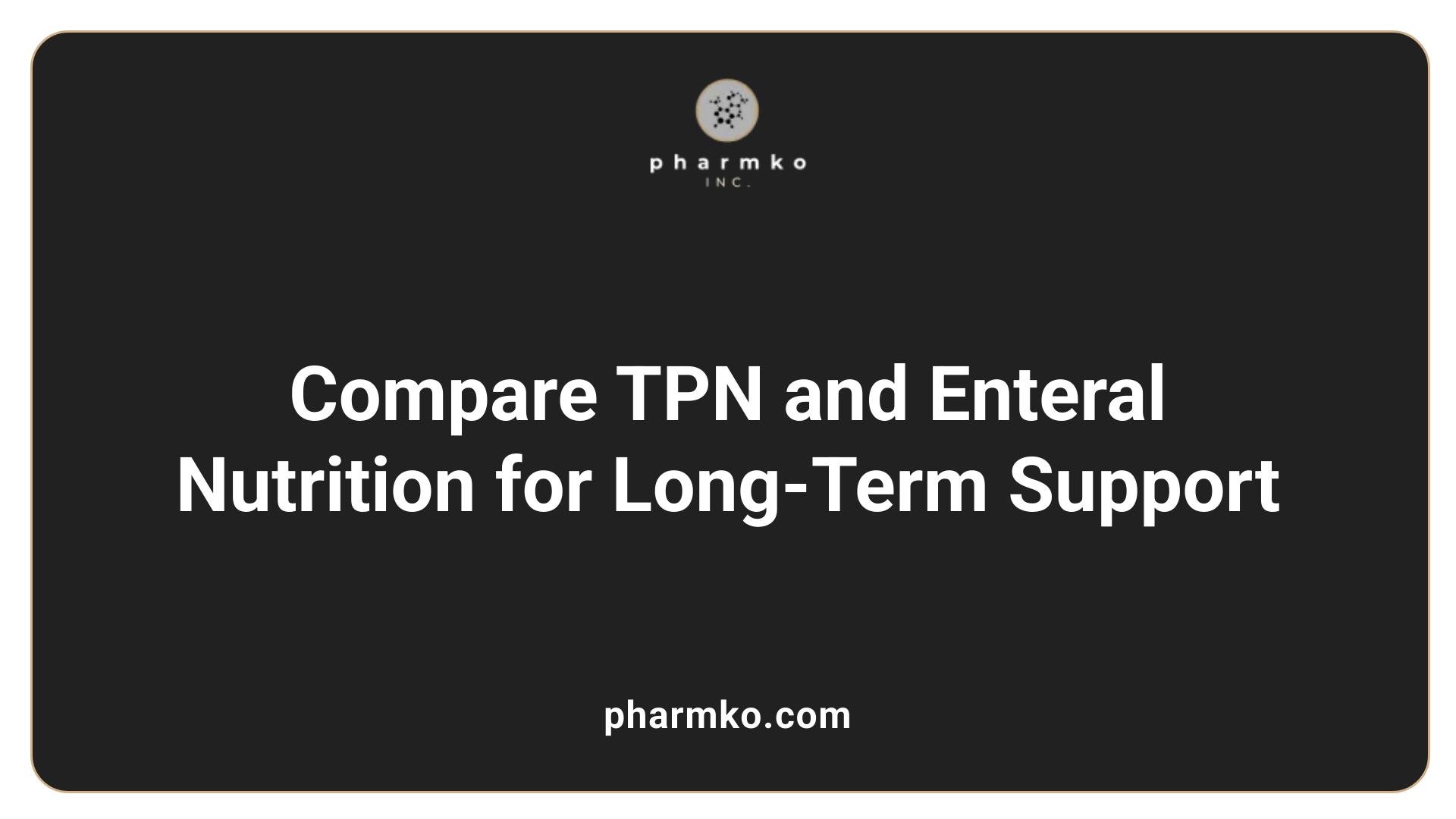 During long hospital stays, managing a patient's nutritional needs involves choosing the most appropriate method to ensure adequate intake while reducing complications. Total parenteral nutrition (TPN) is typically used when the gastrointestinal (GI) tract cannot be used effectively, such as in cases of bowel obstruction, perforation, or severe malabsorption.
During long hospital stays, managing a patient's nutritional needs involves choosing the most appropriate method to ensure adequate intake while reducing complications. Total parenteral nutrition (TPN) is typically used when the gastrointestinal (GI) tract cannot be used effectively, such as in cases of bowel obstruction, perforation, or severe malabsorption.
In contrast, enteral nutrition (EN) involves delivering nutrients via feeding tubes directly into the GI tract. When the gut is functional, EN is preferred because it helps maintain the integrity of the intestinal mucosa, supports immune defense, and reduces the risk of infections.
Studies consistently demonstrate that patients receiving enteral nutrition experience fewer infections, quicker recovery times, and often lower healthcare costs compared to those on TPN. This is because EN leverages the natural digestive process and preserves gut-associated lymphoid tissue.
However, TPN offers complete nutritional support when the gut cannot be used. It delivers a balanced mix of carbohydrates, proteins, fats, vitamins, and minerals directly into the bloodstream through central or peripheral lines. Despite its advantages, TPN is associated with higher risks, including bloodstream infections, catheter-related complications, and metabolic disturbances like hyperglycemia or electrolyte imbalances.
Choosing between TPN and other feeding methods depends largely on the patient's condition and gut functionality. If the patient's GI tract is operable, functional, and accessible, early initiation of enteral nutrition is usually favored to minimize complications. TPN remains a crucial option for those with nonfunctional or inaccessible GI systems, ensuring they still receive essential nutrients.
In summary, during extended hospitalizations, the decision hinges on balancing the benefits of maintaining gut function against the risks associated with TPN. When feasible, enteral feeding is typically linked to better outcomes, but TPN is indispensable when the GI tract cannot sustain nutritional needs.
Implementation Process of TPN in Hospital Settings
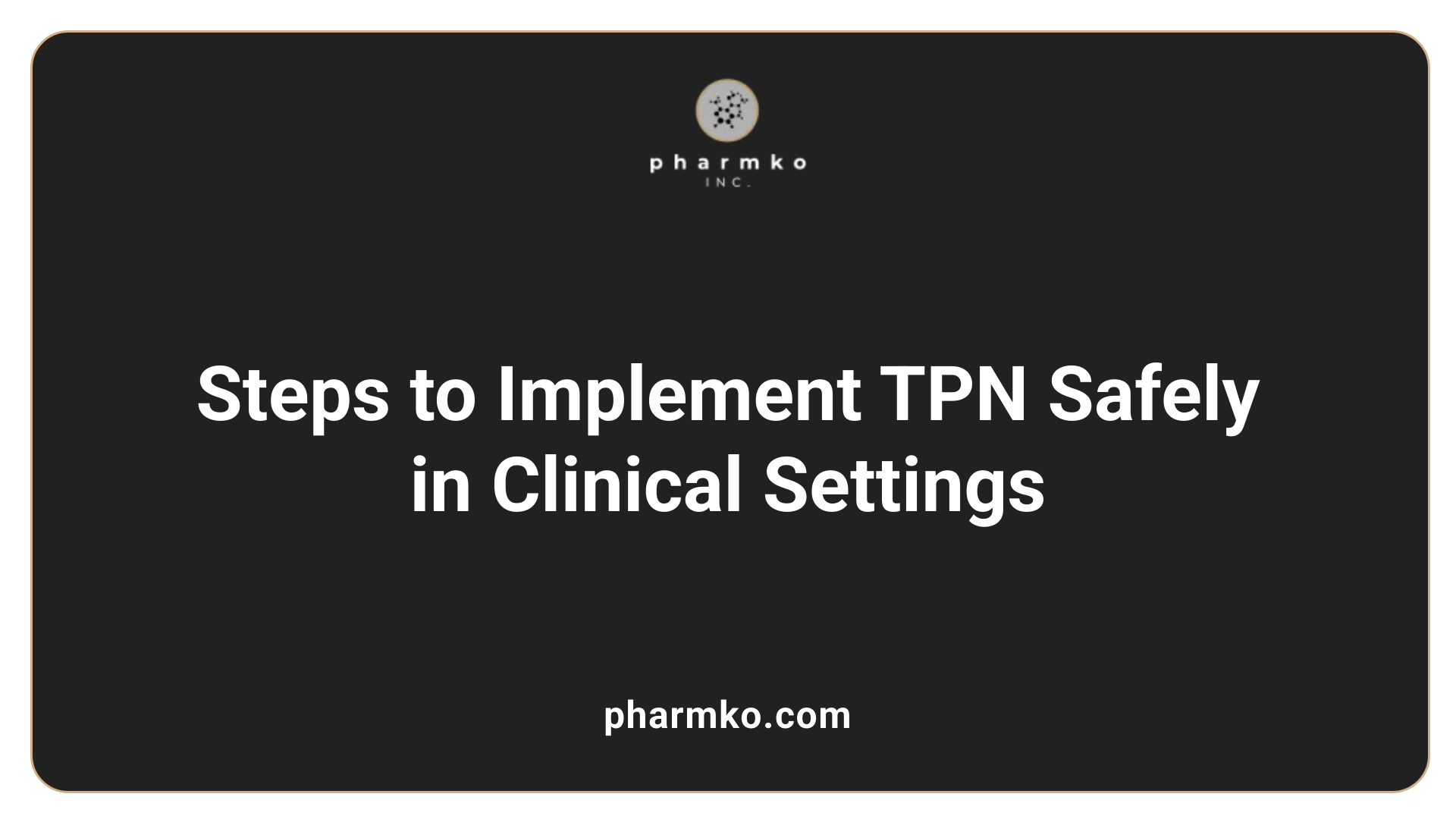
What is the process for implementing TPN in a hospital or clinical setting?
Implementing Total Parenteral Nutrition (TPN) in a hospital involves a carefully coordinated process that begins with comprehensive assessment. A physician along with a dietitian evaluates the patient's nutritional status, gastrointestinal function, and clinical condition to determine if TPN is indicated. Once justified, they order a tailored TPN formulation that meets the patient's specific needs.
The pharmacy plays a critical role by preparing a 3-in-1 TPN mixture, which typically includes amino acids, dextrose, and lipids, designed for continuous infusion over 24 hours. Before administration, the pharmacy verifies all components for accuracy, appropriate concentrations, and expiration dates, ensuring the solution is safe for infusion.
Preparation also requires strict adherence to sterile techniques. Healthcare providers use aseptic procedures, including hand hygiene and sterilized equipment, to set up the infusion. Special filter tubing is attached to prevent particle or bacterial entry, and the infusion rate is gradually increased to minimize risks such as metabolic complications.
Safety checks are performed multiple times during preparation and before connecting the infusion line. These include confirming correct formulation, ensuring appropriate vascular access—preferably a central line due to the high osmolarity of TPN—and checking the patency of the catheter.
During therapy, continuous patient monitoring is essential. Regular blood tests evaluate electrolyte levels, blood glucose, liver and kidney function, and markers of infection. Monitoring helps in early detection of complications like electrolyte imbalances, catheter-related infections, or refeeding syndrome.
Adjustments to the TPN formulation are made based on ongoing evaluations. The clinical team continually evaluates the patient's response, modifies nutrient composition if necessary, and ensures the therapy aligns with the patient's evolving medical condition.
This meticulous process ensures that TPN provides optimal nutritional support while minimizing potential risks, enabling better recovery and clinical outcomes for patients unable to receive enteral nutrition.
Laboratory Monitoring During TPN Therapy
Monitoring laboratory parameters is crucial for patients receiving total parenteral nutrition (TPN) to prevent complications and ensure proper nutritional support.
Essential tests include blood glucose, electrolytes, liver function, and triglyceride levels. Blood glucose should be checked frequently, starting every 6 hours initially, then daily to prevent hypo- or hyperglycemia. Electrolyte panels, measuring sodium, potassium, magnesium, phosphate, and calcium, are typically monitored daily at first and less often once stability is achieved, facilitating early detection and correction of imbalances.
Liver function tests, including ALT, AST, alkaline phosphatase (ALP), and bilirubin, provide insight into potential hepatic complications, which can be influenced by the TPN components or underlying conditions. Triglyceride levels should be assessed weekly in the beginning and then every three months to identify signs of hyperlipidemia, especially in patients receiving lipid emulsions.
Trace elements and vitamins require periodic assessment—usually at baseline and during ongoing therapy—to prevent deficiencies or toxicities. Consistent monitoring allows healthcare providers to adjust TPN formulations promptly, maintaining a safe and effective nutritional regimen for each patient.
Overall, regular laboratory testing plays a central role in the safe management of TPN therapy, helping to reduce risks and optimize patient outcomes.
Considerations for TPN Use in Patients with Chronic Diseases
Are there specific considerations for TPN use in patients with chronic diseases such as cancer or inflammatory bowel disease?
Yes, managing TPN in patients with chronic illnesses like cancer or inflammatory bowel disease (IBD) requires careful planning. These conditions often lead to malnutrition due to reduced oral intake, increased metabolic demands, and losses from gastrointestinal symptoms.
In cancer patients, TPN helps support nutritional needs during treatments such as chemotherapy or radiation, which can impair oral intake or cause nausea and mouth sores. For IBD, especially during active disease flares, TPN can provide bowel rest and prevent malnutrition when enteral nutrition fails or is contraindicated.
However, there are specific points clinicians must consider:
- Disease Activity : Active inflammation or obstruction can influence TPN formulation and risks.
- Infection Risk : Patients with compromised immune systems are more prone to catheter-related bloodstream infections.
- Liver Function : Long-term TPN use can cause hepatic complications, requiring regular liver function monitoring.
- Electrolyte Balance : Close adjustment of minerals and electrolytes is crucial due to common imbalances in these patients.
- Metabolic Monitoring : Regular assessment of blood glucose and triglycerides helps prevent hyperglycemia and lipid issues.
The nutritional plan must be personalized, considering the patient’s disease state, nutritional status, and treatment goals. An interprofessional team—including physicians, dietitians, and nurses—should oversee TPN therapy, ensuring benefits outweigh risks and adjusting formulations based on ongoing response and laboratory results.
Optimizing Nutritional Support for Long-Term Care
In conclusion, TPN remains a cornerstone in the management of malnutrition during long-term hospitalization, especially when enteral nutrition is not feasible. Its success hinges on precise formulation, vigilant monitoring, and multidisciplinary management to mitigate risks and maximize benefits. As healthcare providers continue to refine protocols and leverage advances in nutritional science, patient outcomes can be significantly improved—highlighting the indispensable role of TPN in comprehensive patient care.
References
- Total Parenteral Nutrition - StatPearls - NCBI Bookshelf
- [PDF] Parenteral Nutrition Therapy for Malnutrition - ASPEN
- Overview of Total Parenteral Nutrition in Patients With Inflammatory ...
- Parenteral Nutrition: What it Is, Uses & Types - Cleveland Clinic
- Limited long-term survival after in-hospital intestinal failure requiring ...
- Home parenteral nutrition - Mayo Clinic
- Total parenteral nutrition: A boon to non-functional gastrointestinal ...
- Home Total Parenteral Nutrition (Home TPN) - Nutrishare
- TPN for Cancer Patients - AmeriPharma® Specialty Care













